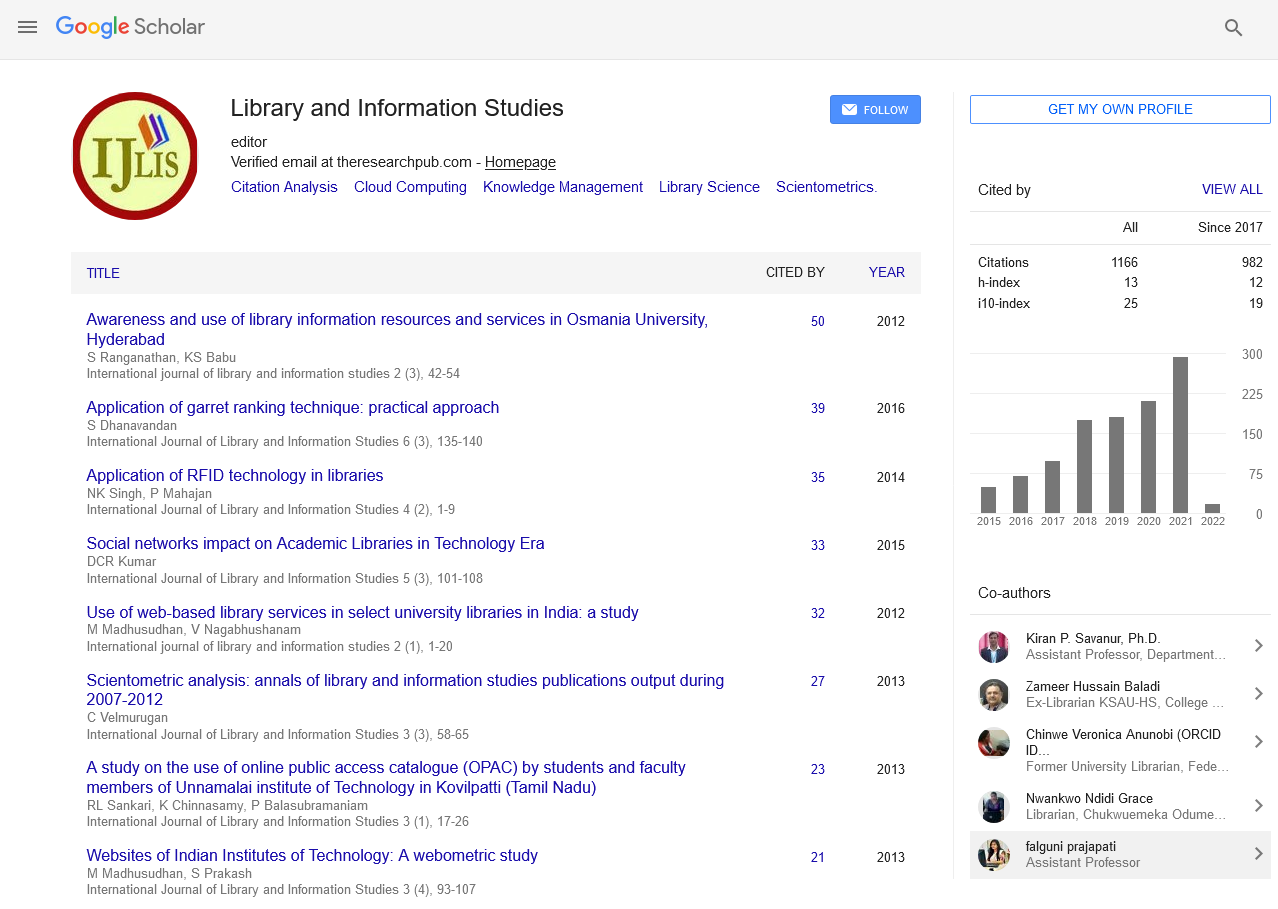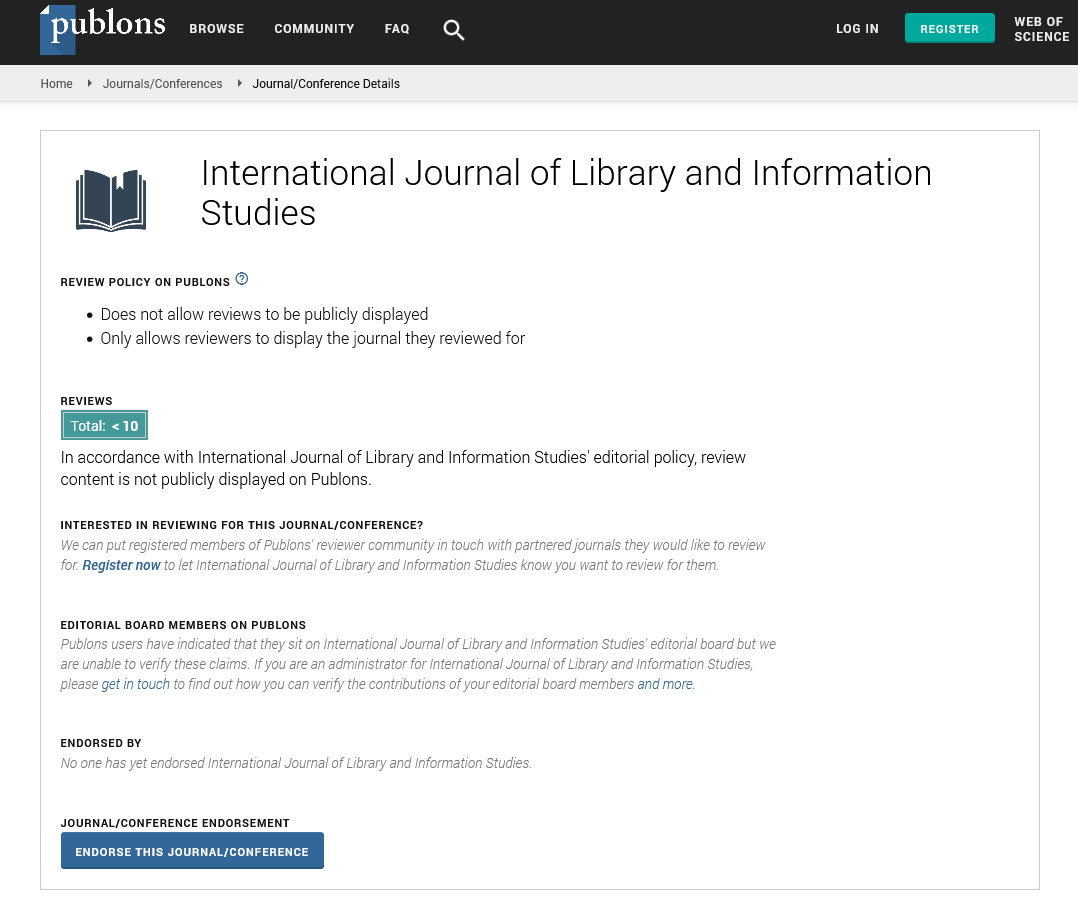Review Article - (2023) Volume 13, Issue 2
Investigating Awareness and Usage of Digital and Services of Medical Deemed University Libraries in Maharashtra: A Study
Sima Ashok Ingole* and Subhash ChavanAbstract
Medical deemed university libraries students in Maharashtra were polled about their knowledge of digital resources. Four medical deemed university libraries of Maharashtra were investigated as part of the study using a questionnaire. Utilization, frequency, locale, and preference of digital resources are all examined in this study. According to the survey, patrons of the Maharashtra medical deemed university libraries had a fair amount of information about digital medical resources. They mostly used them for learning and knowledge upkeep. Students use E-journals, standards, papers, patents, and trade reports. This study investigates the use of digital resources by Maharashtra medical deemed university libraries students. Due to a lack of training or orientation, slow internet, a lack of printing facilities, full text access to the majority of journals, a lack of awareness, and insufficient digital resource consumption, customers of medical deemed university libraries have trouble using digital resources. Statistically, these elements are similar to low satisfaction levels and slow internet speeds. The research leads to better digital library resources and services. This research improved medical e-resources and services. The outcomes could improve virtual culture and digital library services in designated medical deemed university libraries, particularly in Maharashtra. For this research survey, the author considered medical students. The four medical deemed universities received a random distribution of the structured questionnaire. Which examined the distributed questionnaire with speculation and covered 400 UG and P.G. paradigms?
Keywords
Medicine, Serveys, Digital resources, Customers, Printing, Questionnaire
Introduction
This study examines how four deemed medical universities in Maharashtra use their libraries. Students require access to digital library resources in the era of digital medicine. By examining their utilization, librarians and e-resource managers can improve digital materials. The researcher looked at four deemed medical schools in Maharashtra: Pravara institute of medical sciences in Ahemadnar, Krishna institute of medical sciences in Satara, Datta Meghe Institute of medical sciences, Wardha, and MGM university of health sciences in Mumbai. The research on utilizing electronic information resources at the Maharashtra medical institute needs to be improved, and this study addresses that gap.
Today's rapidly evolving ICT environment offers learners and researchers a variety of digital materials to choose from. Information retrieval is made simpler by digital library resources.
Medical libraries use new technologies to acquire, store, retrieve, and disseminate knowledge for students, teaching, research, and clinical practice. Networks or authentication can be used with digital formats to access online library resources from home or the office. Libraries offer users trustworthy and up to date medical information by subscribing to legitimate digital sources. Early on, medical libraries used electronic resources because doctors demanded reliable information. As more children utilize computers, doctors and students alike require internet resources. For teaching, research, and clinical practice, academics require medical data. For professors and other users, the Library held orientation and training sessions.
Digital resources and services
Library collections must include digital resources because they are the most efficient means of international scholarly communication. Because of significant ICT breakthroughs, electronic publication has experienced unprecedented growth in recent years. It has caused the quick production of digital resources with information from all perspectives and across all topic areas worldwide. As technology advances, libraries rely more on digital materials since they are more convenient and less expensive. In the digital age, the Internet, CD-ROMs, online databases, library OPACs, and other widely available digital resources are replacing print media. In recent years, the use of digital resources in scholarly communication has increased significantly.
Literature Review
A literature review is critical for finding studies that academics worldwide have already done. Studies have been found on how library patrons use e-resources and services at the medical deemed university of Maharashtra.
Baskar given that it is a resource that necessitates computer access, an electronic product that supplies a compilation of open data with the goal of commercialization is referred to as an electronic resource. Electronic books, journals, theses and dissertations, reports, OPACs, the Internet and other computer based electronic networks, e-newspapers, e-newsletters, audio, and videos, among other things, are examples of e-resources [1].
Lavanya and Santharooban studied how students of the Eastern university of Sri Lanka's college of agriculture utilized online resources. Few studies have been conducted to examine issues with e-resources and services as well as how various user categories use them. According to thestudy, most students utilize online resources for various educational purposes using theirsmartphones, and they need to be made aware of free and paid university memberships. Thestudy found several barriers to adopting digital resources, including slow internet connectivity,ignorance, and virus attacks. It is advised that pupils be exposed to well-planned informationliteracy programs [2].
Burhansab, Patel Adam, and M Sadik Batcha this study looked at how users of the libraries at the chosen colleges of Solapur university were aware of and used electronic resources. The survey revealed that e-resources are used and known to library users. Users of libraries can find, retrieve, and share research thanks to e-resources. Research production was increased via electronic resources. The most popular electronic resources were databases, research reports, and journals. Research experts heavily invest in these resources. Ongoing information literacy training emphasizing electronic information retrieval would enhance how well people use and comprehend electronic resources [3]. Customers of the library need user training to conduct independent searches. Advanced search strategies, restricted vocabulary, and informational internet use should be taught to simplify the electronic search. Computer capabilities and information retrieval techniques must be updated frequently to stay up to date with information communication technologies.
Singh N According to the author of this article, online resources are increasingly useful for professionals and students performing research. The respondents are infrequent users of e-resources at Bhagat Phool Singh Mahila polytechnic college. 53.21% of BPS Mahila Polytechnic's clients are satisfied. 39.10% of those surveyed admitted using Google to find the required information. Online learning resources are accessed by 44.23% of users. 26.28% of patrons in the university library required access to electronic resources. 32.69% of users use e-resources daily, and 64.74% think they are extremely valuable [4].
Kashyap, Santu Ram and Deepa Sahu the writer clarified due to their assistance in helping students prepare for their notes, assignments, seminars, and other projects, electronic resources have become essential study aids for college students. Most P.G. college science students in Chhattisgarh's Dhamatari district use internet resources. Such as, among others, P.G. Pathshala, newspapers, periodicals, and electronic publications. Overall, this study's findings showed that most participants spent one to two hours online daily [5]. Two hundred seventy-eight respondents, or 78.97%, use electronic books, 343 respondents, or 94.44 respondents use electronic resources for research, and 75 respondents, or 21.31%, spend two to three hours utilizing digital resources. The biggest percentage of respondents 260 (73.86%) were very satisfied with e-resources, as opposed to the lowest percentages 69 (19.60%), 13 (3.69%), and 10 (2.84%). A maximum of 229 respondents (65.06%) stated that using electronic resources was challenging due to delayed downloads.
Khan I, Modak A, and Khan MK, et al. explained that technological resources affect how the medical community consumes, stores, and retains information. Electronic resources are now essential to students and teachers of Uttar Pradesh medical college libraries [6]. It revolutionized information search and dissemination. It shows that most students and instructors use e-resources to find information online. Hence, Uttar Pradesh medical college library students and faculty need effective user education, orientation, workshops, seminars, and more to maximize e-resource utilization.
Saba Habib, et al. The author conducted a cross sectional survey using a questionnaire. Users of the library at Multan medical college received the survey. This survey revealed that most medical library users used medical e-resources for learning and knowledge upkeep and were only "slightly aware" of them. Seldom used databases including MEDLINE, PubMed, springer link, science direct, black well synergy, and ProQuest [7]. The Internet library resources are relatively satisfying to Multan medical students. Customers of medical college libraries had to deal with issues like inadequate training or orientation, bad Internet, power outages or load shedding, limited printing options, restricted access to most journals' full texts, a lack of awareness of information overload, and inadequate I.T. infrastructure. Male and female respondents share medical e-resource awareness, use, satisfaction, and barriers. The results support proactive, effective, and efficient library staff digitization of services and materials. This study improved awareness of medical e-resources and services. The findings could help the Multan division libraries of Pakistani medical colleges promote online resources, digital library services and goods, and virtual culture.
Objectives of the study
This study aimed to determine how users used electronic resources at the medical deemed university Maharashtra. The following objectives were more specific:
•To determine the source of knowledge about using digital information resources bystudents.
•To assess how the medical deemed university libraries services and online resourcesare currently being used.
•To find out how well users are satisfied with online resources and services.
•To determine the purpose and level of usage of the various digital resources andservices by medical students.
•To examine the frequency with which the students utilize the different types of digitalresources.
Scope
The scope of the present study is limited to the libraries of four medical deemed universities in Maharashtra. The study is restricted to the students of four libraries of medical deemed universities in Maharashtra (Table 1).
| Sr. No | Name of medical deemed university | Place | Abbreviation |
|---|---|---|---|
| 1 | Pravara institute of medical sciences, | Ahmednagar | PIMS |
| 3 | Krishna institute of medical sciences, | Satara | KIMS |
| 3 | Datta Meghe institute of medical sciences | Wardha | DMIMS, Wardha |
| 4 | MGM institute of health sciences | Mumbai | MGM, Mumbai |
Table 1: Libraries of medical deemed universities in Maharashtra
As mentioned above, library users were the study's target demographic. Two hundred students from the target population were enrolled at the time; to learn about the numerous electronic information sources used by users.
Discussion
The study was intended to know the current status of awareness and utilization of digital resources and services of selected medical deemed university libraries in Maharashtra. The author has prepared 200 structured questionnaires and distributed them to the library users (under and post graduate students) of the selected medical deemed universities, and 180 questionnaires were received from the library users of respected universities.
Sampling and questionnaire design
Out of the seven medically deemed universities in Maharashtra, a survey was done in 4 libraries. A formal questionnaire was created. Each institute's library patrons were chosen at random. From the four institutes, 200 library patrons were randomly chosen. The survey asked various questions about demographics, e-resource use and access, competencies and training, obstacles and advantages of e-resources, and other topics. Also, two open ended questions inquired about the challenges and advancements faced by the e-resources in the libraries of the respondents' institutions. 180 of the 200 surveys given out to library patrons were returned. 90% of the respondents responded. The data were analyzed using Microsoft excel [8].
Study population
Of the seven medical deemed universities of Maharashtra, there are 04 medically deemed universities selected for the study. The study population constituted library users of 04 medical deemed universities of Maharashtra.
Data analysis
Respondents: The response rate for the data collection from 04 medical universities was 62%. Of 400 participants, only 250 responded; Pravara institute of medical sciences responded 45%; Krishna institute of medical sciences responded 50%. Datta Meghe institute of medical sciences, Wardha, responded 80%; and MGM institute of health sciences, Mumbai, responded 75%. The responses from various medical universities are displayed in tabulation (Table 2 and Figure 1).
| Sr. No | Name of medical deemed university | Distributed questionnaire | Responded | Percentage (%) |
|---|---|---|---|---|
| 1 | Pravara institute of medical sciences | 100 | 45 | 45% |
| 2 | Krishna institute of medical sciences | 100 | 50 | 50% |
| 3 | Datta Meghe institute of medical sciences | 100 | 80 | 80% |
| 4 | MGM institute of health sciences | 100 | 75 | 75% |
| Total | 400 | 250 | 62% |
Table 2: Descriptive statistics of respondents from different medical deemed universities.

Figure 1: Descriptive statistics of respondents from different medical deemed universities.
Source of information about the e-resources: Table 3 explains the source of information about digital resources by medical deemed university students. The majority of sources for students are 27% library web site/portals, 22% library orientation/induction programs, 27% colleagues/friends colleagues, 13% faculty of department, 11% college websites, and 1% through social media used for getting information about digital resources (Figure 2).
| Sources of information | Overall sources used from 4 deemed university | Percentage (9%) |
|---|---|---|
| Library web site/portal | 67 | 27 |
| Library’s orientation/induction programs | 54 | 22 |
| Your colleagues/friends colleagues | 67 | 27 |
| Through social media | 1 | 1 |
| College website | 28 | 11 |
| Faculty of your department | 33 | 13 |
Table 3: Descriptive statistics of respondent’s source of information about the digital resources.
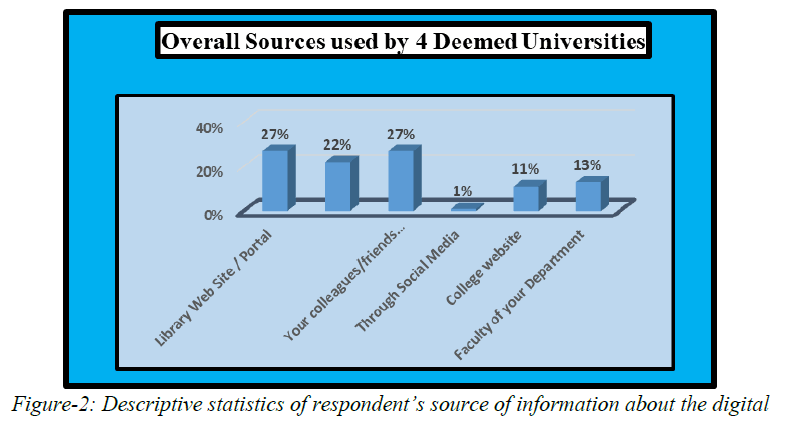
Figure 2: Descriptive statistics of respondent’s source of information about the digital resources.
Usage as per types of digital resources: The accessible digital resource types are shown in Table 4 percent of respondents use electronic journals, 48 percent use electronic books, 9 percent use bibliographic databases, and 14 percent use CD-ROM databases. 5% of respondents use indexing and abstracting databases, whereas 8% of respondents use E-thesis/dissertation. The vast majority of respondents access electronic books as digital resources (Figure 3).
| Type of E-resources | Overall responded accessed by types of digital resources | Percentage (%) |
|---|---|---|
| E-Journals | 92 | 37% |
| E-Books | 120 | 48% |
| Bibliographic databases | 22 | 9% |
| CD-ROM database | 35 | 14% |
| E-thesis/dissertation | 20 | 8% |
| Indexing/abstracting database | 13 | 5% |
Table 4: Descriptive statistics of respondents accessed by types of digital resources.
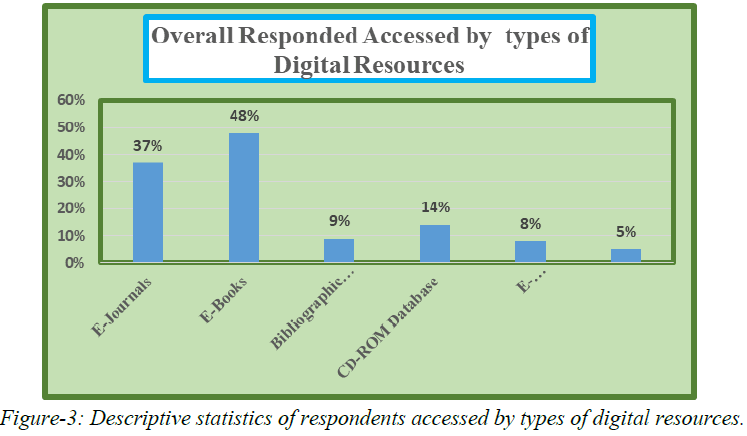
Figure 3: Descriptive statistics of respondents accessed by types of digital resources.
User awareness and usage of e-resources and services: This Table 5 shows how many respondents know the type of databases mentioned in the questionnaire. Different databases were asked from the respondents, and the respondents responded as 95% E-Books, 85% were known about E-journal, 10% were known about CD-ROM databases, 63% were known about abstracting and bibliographic database, 8% were known about indexing databases, 65% were known about institutional repositories, 42% were known about E-thesis, this table showed very less awareness about E standard, E-patents, newsletter and subject specific portals (Figure 4).
| Digital information resource | Overall awareness from 4 deemed university | Percentage (%) |
|---|---|---|
| E-journals | 213 | 85% |
| E-books | 238 | 95% |
| E-newsletter | 6 | 3% |
| Bibliographic/abstracting databases | 159 | 63% |
| Indexing database | 20 | 8% |
| CD-ROM database | 24 | 10% |
| E-thesis/dissertation | 104 | 42% |
| E-standards | 16 | 6% |
| E-patents | 15 | 6% |
| Institutional repository | 163 | 65% |
| Institute publication | 63 | 25% |
| Subject specific portals | 6 | 2% |
Table 5: Descriptive statistics of respondents' awareness of digital resources and services of medical colleges.
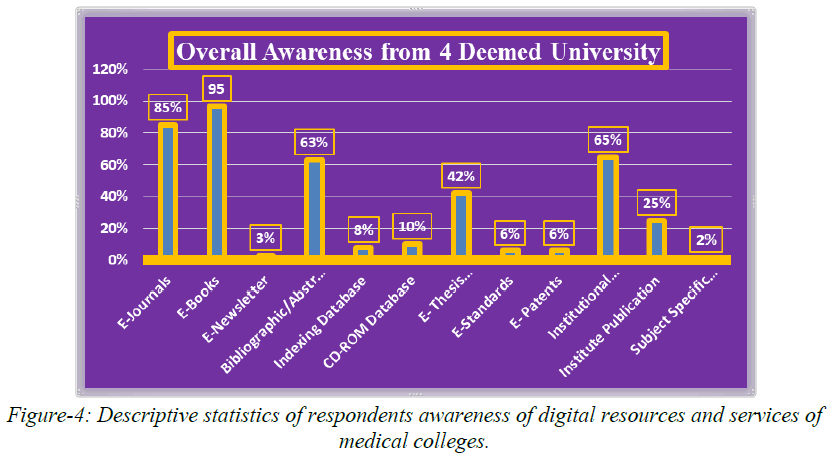
Figure 4: Descriptive statistics of respondents awareness of digital resources and services of medical colleges.
Usage of digital resources and services of medical colleges: This Table 6 shows how many respondents know the type of databases mentioned in the questionnaire. Different databases were asked from the respondents, which the respondents responded as 92% were E-books, 78% were known about E-journal, 34% were known about E-thesis, 16% were known about CD-ROM databases, 43% were known about abstracting and bibliographic databases, 10% of were known about indexing database, 31% were known about institutional repository, this table showed very less usage about E standard, E-patented, subject specific portals and E-newsletter (Figure 5).
| Digital information resource | Overall usage from 4 deemed university | Percentage (%) |
|---|---|---|
| E-journals | 194 | 78% |
| E-books | 230 | 92% |
| E-newsletter | 6 | 3% |
| Bibliographic and abstracting database | 107 | 43% |
| Indexing database | 25 | 10% |
| CD-ROM database | 39 | 16% |
| E-thesis/dissertation | 85 | 34% |
| E-standards | 4 | 2% |
| E-patents | 4 | 2% |
| Institutional repository | 78 | 31% |
| Institute publication | 36 | 14% |
| Subject specific portals | 6 | 2% |
Table 6: Descriptive statistics of respondents usage of digital resources and services of medical colleges.
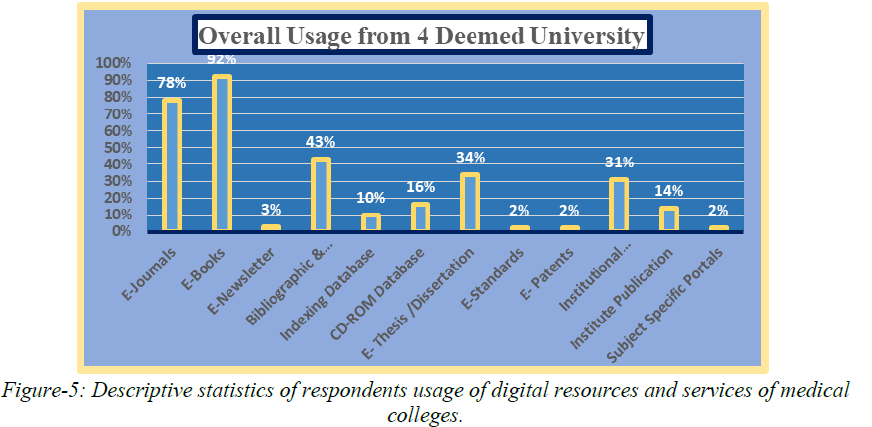
Figure 5: Descriptive statistics of respondents usage of digital resources and services of medical colleges.
Purposes of using digital resources and services: The participants were prompted to state why they used the online tools and services. Most respondents (88%) have used digital tools and services to prepare assignments. Most participants (68%) were using e-resources and services for learning. 43% of respondents were used to prepare for research work. 39% of respondents were used to prepare for searching the literature for research and other using purpose presented in Table 7 (Figure 6).
| Purpose | Overall purpose of using medical digital resources and services | Percentage (%) |
|---|---|---|
| Learning | 171 | 68% |
| For searching the literature for research | 97 | 39% |
| For updated subject knowledge | 55 | 22% |
| To write research papers | 107 | 43% |
| For career development | 45 | 18% |
| For preparing assignments | 221 | 88% |
Table 7: Descriptive statistics of respondents for purposes of using digital resources and services.
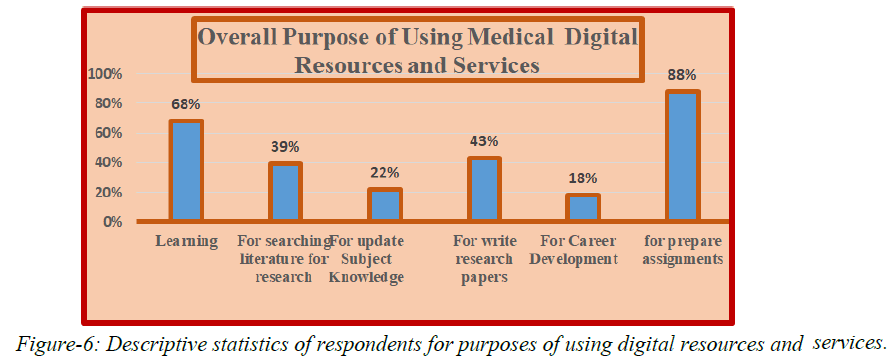
Figure 6: Descriptive statistics of respondents for purposes of using digital resources and services.
Frequency of visits to the library: Medical deemed university wise analysis displays that the preponderance of users from Krishna institute of medical sciences, Pravara institute of medical sciences, Datta Meghe institute of medical sciences, Wardha, and MGM institute of health sciences, Mumbai majority of the users from the college of 52% have given priority to daily frequency, another 21% visit library twice a week; 12% of users visit the library Weekly, 6% visitor at occasionally, and 5% have given priority on monthly, apart from this, about 4% users never visit the library (Table 8 and Figure 7).
| Frequency | Frequency of visits to the library | Percentage (%) |
|---|---|---|
| Daily | 130 | 52% |
| Twice a week | 53 | 21% |
| Weekly | 31 | 12% |
| Monthly | 13 | 5% |
| Occasionally | 14 | 6% |
| Never | 9 | 4% |
Table 8: Descriptive statistics of respondents of frequency of visit to the library (colleges wise).
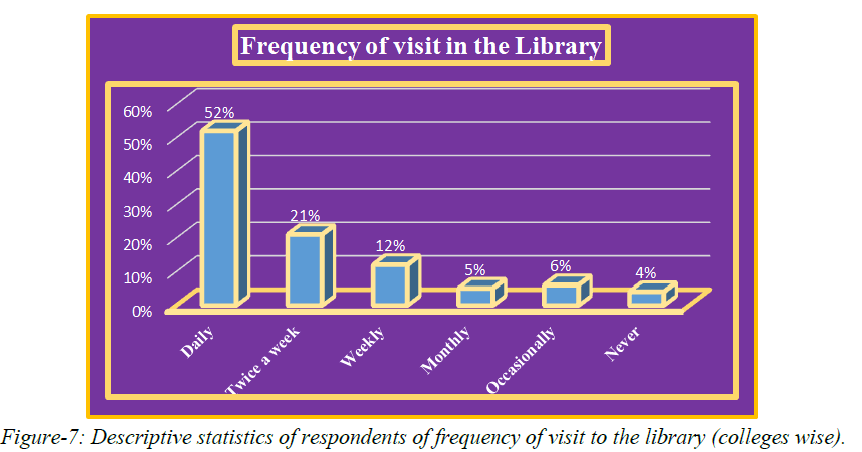
Figure 7: Descriptive statistics of respondents of frequency of visit to the library (colleges wise).
Purpose of visiting the library: The overall analysis of the replies to the question about the reason for the library visit reveals that the primary reason for the user community's visit to the various selected college libraries. 92% of visitors to the library come to check out and return books. Consequently, the users (87%) were ranked second for data collecting for writing tasks on specific information in their fields of study. Thus, newspaper reading received a third-place rating from users (60%) and support for acquiring literature for research was expressed by roughly (52%) of users (Table 9 and Figure 8).
| Purpose | Overall purpose | Percentage (%) |
|---|---|---|
| To get the printout of the required material | 76 | 30% |
| To know the availability of material | 46 | 18% |
| To get material for class assignments | 217 | 87% |
| To issue and return books | 229 | 92% |
| To get literature for research | 131 | 52% |
| To newspaper reading | 151 | 60% |
Table 9: Descriptive statistics of respondents of purpose of library visits.
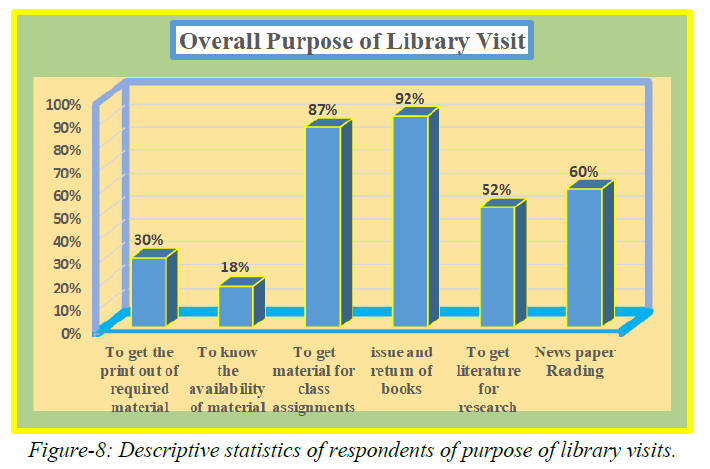
Figure 8: Descriptive statistics of respondents of purpose of library visits.
Satisfaction with digital information resources and services: Table 10 shows the respondents satisfaction with the services and resources for digital information that are readily available. According to the table, most respondents (46%) users are very satisfied students, (25%) are satisfied students. This table also shows that only 4% percent of respondents are dissatisfied with the current digital information resources and services (Figure 9).
| Satisfaction level | Overall, satisfaction | Percentage (%) |
|---|---|---|
| Very satisfied | 114 | 46% |
| Satisfied | 62 | 25% |
| Neutral | 46 | 18% |
| Dissatisfied | 10 | 4% |
| No opinion | 18 | 7% |
Table 10: Survey respondents satisfaction with digital information resources and services, in terms of descriptive statistics.
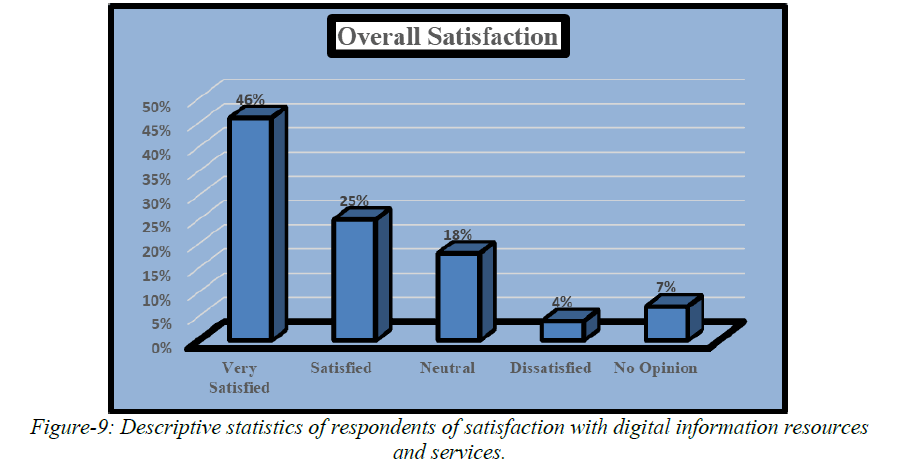
Figure 9: Descriptive statistics of respondents of satisfaction with digital information resources and services.
Conclusion
The use, storage, and preservation of medical information have all been significantly changed by digital resources. Customers of the Maharashtra medical deemed university libraries heavily utilize electronic resources. Sharing and finding information have changed as a result of technology. It demonstrates how most educators and learners use online resources to locate essential data. To properly use the study's e-resources, students at the medical considered university of Maharashtra require user instruction, orientation lessons, workshops, seminars, and more. Of the 400 student questionnaires sent at random, 250 had good responses. Data came from observation, interviews, and surveys. The conclusions came from the processed and tabulated results. To manage documents, information workers need to use modern tools. Professionals must set up websites and institutional repositories. Library workers must instruct and guide patrons to maximize the use of information. Customers of the Maharashtra medical university library were surveyed regarding their use of digital resources. According to the poll, those who utilize libraries frequently use digital resources. Users of libraries can find, retrieve, and share research thanks to e-resources. Electronic resources improved their research output. The most popular online resources were e-databases, e-research reports, and e-journals. Infrastructure modifications may, however, motivate research scientists to use these technologies more frequently due to their high cost. Regularly scheduled organized information literacy training that strongly emphasizes electronic information retrieval will enhance the usage of electronic resources and raise knowledge of their many advantages. Customers require guidance if they want to do autonomous searches.
This study showed that the evaluated libraries offer various digital services and resources. Users are satisfied with digital forms, and libraries save time and money. For libraries and information centers, the rapid growth of technology has brought about new problems. Due to the information revolution, new strategies for promoting library resources and services are now required to meet user information needs. Librarians have acquired the latest equipment and publications to meet consumers information demands.
Suggestions
The following recommendations are made to improve the usage of digital resources among medical students in light of the thorough study's findings.
•
To help patrons better use their information resources, the library should offer anonline help menu on the search page.
•
The library and information centre should notify users when new print and electronicmaterials become available.
•
Medical schools should regularly schedule seminars, workshops, and orientationprograms to keep staff and students updated with recent information technology.
•
The library has to regularly evaluate and assess how well the digital resources aremeeting the users demands for information.
•
The library has a strong infrastructure and knowledgeable staff. Responses from therelevant colleges should glean as much advice from them as possible about how to usedigital resources.
References
- Kenchakkanavar, and Anand Y. "Types of e-resources and its utilities in library." International Journal of Information Sources and Services 1.2 (2014): 97-104.
- Lavanya, J., and Santharooban S. "Usage of online resources by the undergraduates attached to the faculty of agriculture, Eastern university, Sri Lanka." Journal of the University Librarians Association of Sri Lanka 21.2 (2018): 89-105.
- Burhansab, P. A., Batcha, D. M. S., and Ahmad, M. "Investigating awareness and usage of electronic resources by the library users of selected colleges of Solapur university." arXiv Preprint arXiv 2102 (2021): 10917.
- Singh, N. "Use of E-resources by the students in Bhagat Phool Singh Mahila polytechnic, Sonipat, Haryana: A study." International Journal of Research in Library Science 7.3 (2021): 182-187.
- Kashyap, S. R., and Sahu, D. "Use of E-resources by post graduate college students of science of dhamatari district, Chhattisgarh: A study." International Journal of Research in Library Science 7.4 (2021): 7-13.
- Gautam, A. S., and Sinha, M. K. "Use of electronic resources among research scholars and faculty members of university of Allahabad, Uttar Pradesh, India: A survey." Library Progress 37.2 (2017): 182-201.
- Habib, S., Asad, I. H., and Bahader, M. "Use of electronic resources among users of medical college libraries in Multan division, Pakistan." Library Philosophy and Practice 7242 (2022).
- Gibson, A. N., and Hughes-Hassell, S. "We will not be silent: Amplifying marginalized voices in LIS education and research." The Library Quarterly 87.4 (2017): 317-329.
Author Info
Sima Ashok Ingole* and Subhash ChavanReceived: 11-May-2023, Manuscript No. IJLIS-23-98576; Editor assigned: 15-May-2023, Pre QC No. IJLIS-23-98576 (PQ); Reviewed: 25-May-2023, QC No. IJLIS-23-98576; Revised: 11-Jul-2023, Manuscript No. IJLIS-23-98576 (R); Published: 18-Jul-2023, DOI: 10.35248/2231-4911.23.13.854
Copyright: This is an open access article distributed under the terms of the Creative Commons Attribution License, which permits unrestricted use, distribution, and reproduction in any medium, provided the original work is properly cited.
Call for Papers
Authors can contribute papers on
What is Your ORCID
Register for the persistent digital identifier that distinguishes you from every other researcher.
Social Bookmarking
Know Your Citation Style
American Psychological Association (APA)
Modern Language Association (MLA)
American Anthropological Association (AAA)
Society for American Archaeology
American Antiquity Citation Style
American Medical Association (AMA)
American Political Science Association(APSA)



